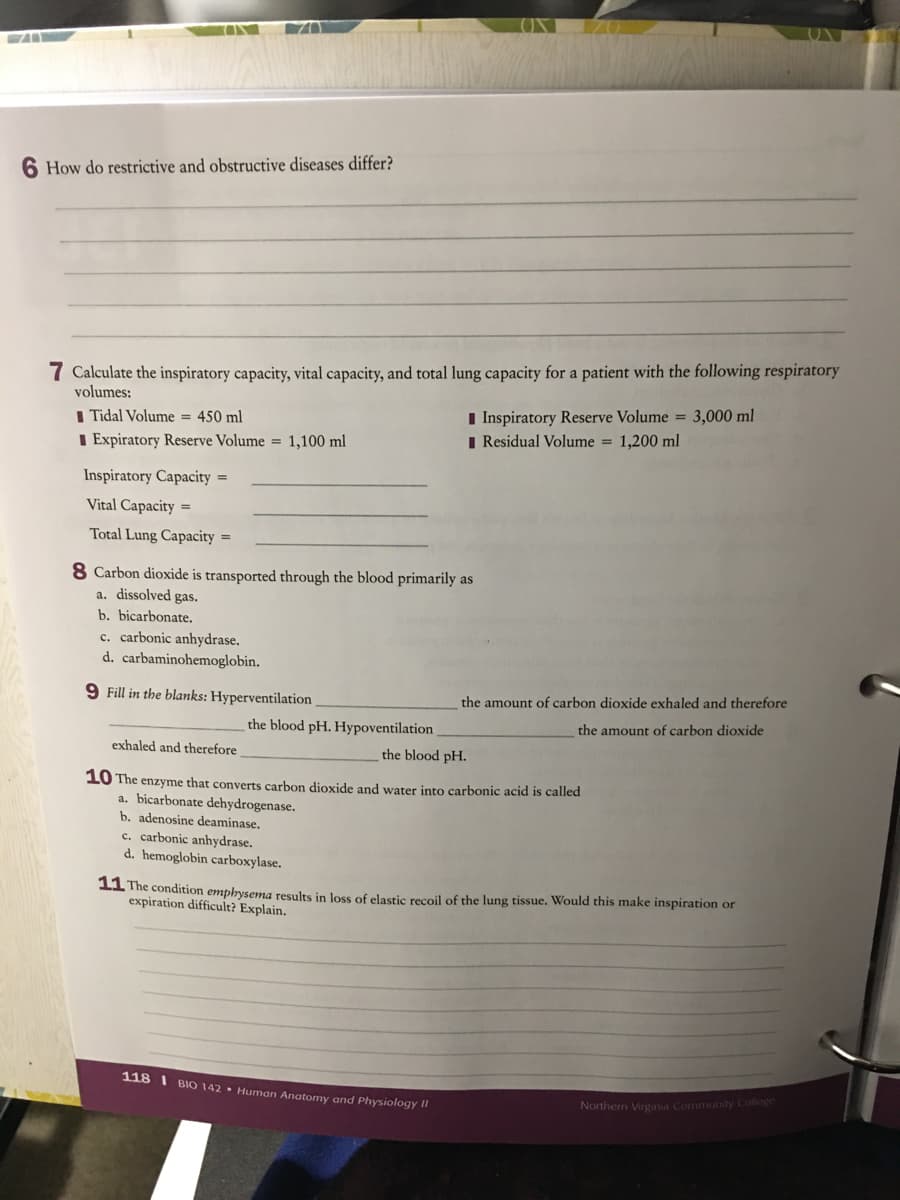Biology 2e
2nd Edition
ISBN:9781947172517
Author:Matthew Douglas, Jung Choi, Mary Ann Clark
Publisher:Matthew Douglas, Jung Choi, Mary Ann Clark
Chapter39: The Respiratory System
Section: Chapter Questions
Problem 9RQ: The total lung capacity is calculated using which of the following formulas? residual volume + tidal...
Related questions
Question
Can you please help me on all these questions

Transcribed Image Text:WAR
6 How do restrictive and obstructive diseases differ?
7 Calculate the inspiratory capacity, vital capacity, and total lung capacity for a patient with the following respiratory
volumes:
I Tidal Volume = 450 ml
I Expiratory Reserve Volume = 1,100 ml
I Inspiratory Reserve Volume = 3,000 ml
I Residual Volume = 1,200 ml
Inspiratory Capacity =
Vital Capacity =
Total Lung Capacity =
8 Carbon dioxide is transported through the blood primarily as
a. dissolved gas.
b. bicarbonate.
c. carbonic anhydrase.
d. carbaminohemoglobin.
9 Fill in the blanks: Hyperventilation
the amount of carbon dioxide exhaled and therefore
the blood pH. Hypoventilation
the amount of carbon dioxide
exhaled and therefore
the blood pH.
10 The enzyme that converts carbon dioxide and water into carbonic acid is called
a. bicarbonate dchydrogenase.
b. adenosine deaminase.
c. carbonic anhydrase.
d. hemoglobin carboxylase.
11 The condition emphysema results in los of elastic recoil of the lung tissue. Would this make inspiration or
expiration difficult? Explain.
118 I BIO 142 - Human Anatomy and Physiology II
Northern Virginia Community College
Expert Solution
This question has been solved!
Explore an expertly crafted, step-by-step solution for a thorough understanding of key concepts.
This is a popular solution!
Trending now
This is a popular solution!
Step by step
Solved in 2 steps

Knowledge Booster
Learn more about
Need a deep-dive on the concept behind this application? Look no further. Learn more about this topic, biology and related others by exploring similar questions and additional content below.Recommended textbooks for you

Biology 2e
Biology
ISBN:
9781947172517
Author:
Matthew Douglas, Jung Choi, Mary Ann Clark
Publisher:
OpenStax

Cardiopulmonary Anatomy & Physiology
Biology
ISBN:
9781337794909
Author:
Des Jardins, Terry.
Publisher:
Cengage Learning,

Biology: The Dynamic Science (MindTap Course List)
Biology
ISBN:
9781305389892
Author:
Peter J. Russell, Paul E. Hertz, Beverly McMillan
Publisher:
Cengage Learning

Biology 2e
Biology
ISBN:
9781947172517
Author:
Matthew Douglas, Jung Choi, Mary Ann Clark
Publisher:
OpenStax

Cardiopulmonary Anatomy & Physiology
Biology
ISBN:
9781337794909
Author:
Des Jardins, Terry.
Publisher:
Cengage Learning,

Biology: The Dynamic Science (MindTap Course List)
Biology
ISBN:
9781305389892
Author:
Peter J. Russell, Paul E. Hertz, Beverly McMillan
Publisher:
Cengage Learning

Basic Clinical Lab Competencies for Respiratory C…
Nursing
ISBN:
9781285244662
Author:
White
Publisher:
Cengage

Anatomy & Physiology
Biology
ISBN:
9781938168130
Author:
Kelly A. Young, James A. Wise, Peter DeSaix, Dean H. Kruse, Brandon Poe, Eddie Johnson, Jody E. Johnson, Oksana Korol, J. Gordon Betts, Mark Womble
Publisher:
OpenStax College

Biology: The Unity and Diversity of Life (MindTap…
Biology
ISBN:
9781337408332
Author:
Cecie Starr, Ralph Taggart, Christine Evers, Lisa Starr
Publisher:
Cengage Learning